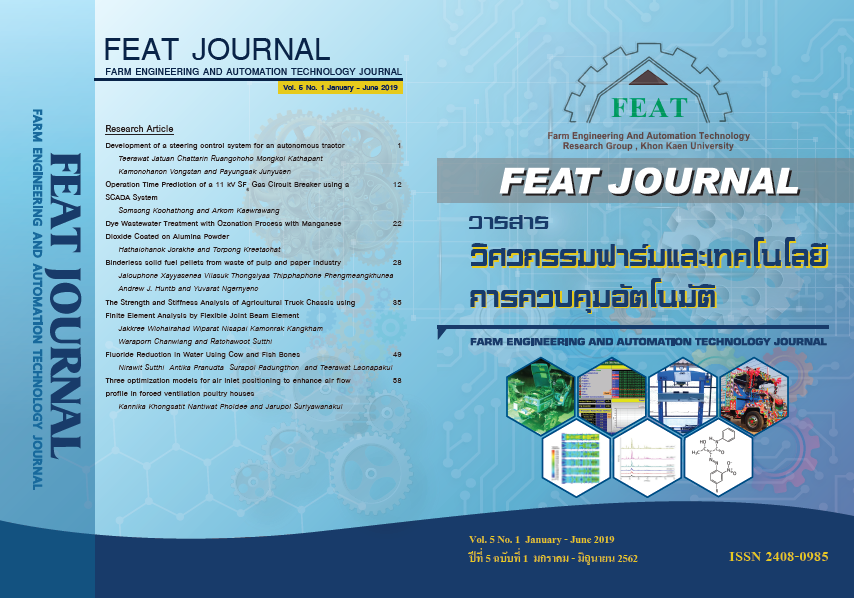การวิเคราะห์ความแข็งแรงและความแข็งตึงของโครงฐานรถบรรทุกใช้งานเกษตรกรรมด้วยระเบียบวิธีไฟไนต์เอเลเมนต์โดยเอเลเมนต์แบบคานที่มีจุดเชื่อมต่อแบบยืดหยุ่น
Main Article Content
บทคัดย่อ
ปัจจุบันการขนส่งผลผลิตทางการเกษตรด้วยรถบรรทุกใช้งานเกษตรกรรม (รย.15 หรือ รถอีแต๋น) ได้มีบทบาทสำคัญอย่างยิ่งในประเทศไทย จากสถิติพบว่าจำนวนรถบรรทุกใช้งานเกษตรกรรมเพิ่มมากขึ้นอย่างต่อเนื่องในแต่ละปี งานวิจัยนี้จึงได้ทำการวิเคราะห์ความแข็งแรงและความแข็งตึงของโครงสร้างหลักรถบรรทุกใช้งานเกษตรกรรมด้วยระเบียบวิธีไฟไนต์เอเลเมนต์ โดยเลือกรถบรรทุกใช้งานเกษตรกรรมของอู่อนันต์การช่าง อำเภอจัตุรัส จังหวัดชัยภูมิ โดยทำการสร้างแบบจำลองทางคอมพิวเตอร์ของโครงฐานบนโปรแกรมคอมพิวเตอร์ช่วยในการวิเคราะห์ทางวิศวกรรม และพิจารณาภายใต้สมมติฐานภาระกระทำแบบสถิตศาสตร์และสมบัติวัสดุแบบยืดหยุ่นเชิงเส้น โดยเลือกใช้เอเลเมนต์แบบคานที่มีจุดเชื่อมต่อยืดหยุ่น ภาระที่กระทำต่อโครงสร้างเป็นภาระพื้นฐาน 4 รูปแบบ ได้แก่ ภาระการดัด ภาระการบิด ภาระกระทำในแนวยาวและภาระกระทำในแนวด้านข้าง ผลการศึกษาพบว่าค่าความเค้นเสียหายสูงสุดเกิดในกรณีภาระกระทำในแนวด้านข้างซึ่งมีค่าเท่ากับ 155.21 เมกกะพาสคัล และระยะการเสียรูปสูงสุดของโครงฐานในกรณีภาระดัดมีค่าเท่ากับ 5.65 มิลลิเมตร เมื่อพิจารณาค่าความแข็งตึงต่อการดัดและการบิดตัวของโครงฐาน พบว่ามีค่าเท่ากับ 20,462.83 นิวตันต่อมิลลิเมตร และ 4,700.44 นิวตัน-เมตรต่อองศา ตามลำดับ ท้ายที่สุดได้ทำการยืนยันความถูกต้องของผลการวิเคราะห์ด้วยโปรแกรมช่วยทางวิศวกรรมโดยเปรียบเทียบกับผลการทดสอบโครงสร้างทดสอบอย่างง่าย สำหรับการวิเคราะห์ความแข็งตึงบิด พบว่า ค่าความแข็งตึงบิดจะมีค่าความผิดพลาดร้อยละ 8.3 และ 0.6 เมื่อวิเคราะห์แบบจุดเชื่อมต่อแข็งเกร็งและแบบจุดเชื่อมต่อยืดหยุ่น ตามลำดับ ซึ่งการค้นคว้าวิจัยในทุกหัวข้อในครั้งนี้ จะเป็นประโยชน์ในด้านของการเพิ่มความปลอดภัยของรถบรรทุกใช้งานเกษตรกรรมเพื่อประโยชน์ต่อเกษตรกรสืบไป
Article Details
วารสารวิศวกรรมฟาร์มและเทคโนโลยีควบคุมอัตโนมัติ (FEAT Journal) มีกําหนดออกเป็นราย 6 เดือน คือ มกราคม - มิถุนายน และ กรกฎาคม - ธันวาคม ของทุกปี จัดพิมพ์โดยกลุ่มวิจัยวิศวกรรมฟาร์มและเทคโนโลยีควบคุมอัตโนมัติ คณะวิศวกรรมศาสตร์มหาวิทยาลัยขอนแก่น เพื่อเป็นการส่งเสริมและเผยแพร่ความรู้ ผลงานทางวิชาการ งานวิจัยทางด้านวิศวกรรมศาสตร์และเทคโนโลยีพร้อมทั้งยังจัดส่ง เผยแพร่ตามสถาบันการศึกษาต่างๆ ในประเทศด้วย บทความที่ตีพิมพ์ลงในวารสาร FEAT ทุกบทความนั้นจะต้องผ่านความเห็นชอบจากผู้ทรงคุณวุฒิในสาขาที่เกี่ยวข้องและสงวนสิทธิ์ ตาม พ.ร.บ. ลิขสิทธิ์ พ.ศ. 2535
เอกสารอ้างอิง
[2] กฎกระทรวงฉบับที่ 11 (พ.ศ. 2525) ออกตามความในพระราชบัญญัติรถยนต์ พ.ศ. 2522 (2525, 11 พฤษภาคม). ราชกิจจานุเษกษา. เล่ม 99 ตอนที่ 65., หน้า 72-5.
[3] ประกาศกระทรวงอุตสาหกรรม ฉบับที่ 2093 (พ.ศ. 2538) ออกตามความในพระราชบัญญัติมาตรฐานผลิตภัณฑ์อุตสาหกรรม พ.ศ. 2511 เรื่องกำหนดมาตรฐานผลิตภัณฑ์อุตสาหกรรม รถใช้งานเกษตรกรรม: รถขนส่งเกษตร. (2538, 26 ธันวาคม). ราชกิจจานุเบกษา. เล่ม 112 ตอนที่ 103ง. หน้า 63-80.
[4] ฝ่ายบริหารคลัสเตอร์และโปรแกรมวิจัย และฝ่ายนโยบายกลยุทธ์คลัสเตอร์และโปรแกรมวิจัย. เอกสารข้อเสนอเชิงนโยบาย แนวทางการจดทะเบียนรถอเนกประสงค์เพื่อการใช้งานเกษตรกรรมของประเทศไทย. กรุงเทพมหานคร: สำนักงานพัฒนาวิทยาศาสตร์และเทคโนโลยีแห่งชาติ. 2554.
[5] Wichairahad J, Kaewsarn P, Nisapai W, Tan-Intara-Art S, Chanwiang W .The strength analysis of an agriculture truck chassis using finite element method. KKU ENGINEERING
JOURNAL. 2016; 43(S2): 267-70.
[6] Lee MMK. Strength Stress and Fracture Analyses of Offshore Tubular Joints using Finite Elements. Journal of Constructional Steel Research. 1999; 51: 265-86.
[7] Pey LP, Soh AK and Soh CK. Partial implementation of compatibility conditions in modeling tubular joints using brick and shell elements. Finite Elements in Analysis and Design. 1995; 20: 127-38.
[8] Stigliano G, Mundo D, Donders S, Tamarozzi T. Advanced Vehicle Body Concept Modeling Approach Using Reduced Models of Beams and Joints. Proceedings of International Conference on Noise and Vibration Engineering 2010: 4179-90
[9] Alcala E, Badea F, Martin A, Aparicio F. Methodology for the accuracy improvement of FEM beam type T-junctions of buses and coaches structures. International Journal of Automotive Technology. 2013; 14(5): 817-27.
[10] Chinnaraj K, Sathya Prasad M, Lakshmana R C. Experimental Analysis and Quasi-Static Numerical Idealization of Dynamic Stresses on a Heavy Truck Chassis Frame Assembly. Applied Mechanics and Materials. 2008;13-14: 271-80.
[11] Ingole NK, Bhope DV. Stress analysis of tractor trailer chassis for self weight reduction. International Journal of Engineering Science and Technology. 2011;3(9): 7218-25.
[12] Kamal Asker H, Salih Dawood T, Fawzi Said A. Stress Analysis of standard Truck Chassis during ramping on Block using Finite Element Method. ARPN Journal of Engineering and Applied Sciences. 2012;7(6): 641-48.
[13] Ravi Chandra M, Sreenivasulu S, Altaf H S. Modeling and Structural analysis of heavy vehicle chassis made of polymeric composite material by three different cross sections. International Journal of Modern Engineering Research. 2012; 2(4): 2594-600.
[14] Patil BH, Kachave SD, Deore ER. Stress Analysis of Automotive Chassis with Various Thicknesse. IOSR Journal of Mechanical and Civil Engineering. 2013;6(1): 44-9.
[15] Rooppakhun S, Wichairahad J. The Strength Analysis of a Bus Superstructure Based on the Accuracy Improvement of T-Junction Flexible Joint Stiffness. International Journal of Engineering & Technology. 2018; 7(3.24): 62-7.
[16] ประกาศกระทรวงอุตสาหกรรม ฉบับที่ 2194 ( พ.ศ. 2539 ) ออกตามความในพระราชบัญญัติมาตรฐานผลิตภัณฑ์อุตสาหกรรม พ.ศ. 2511 เรื่อง แก้ไขมาตรฐานผลิตภัณฑ์อุตสาหกรรม เหล็กโครงสร้างรูปพรรณรีดร้อน (แก้ไขครั้งที่ 1). (2539, 19 กันยายน). ราชกิจจานุเบกษา. เล่ม 113 ตอนที่ 87ง. หน้า 35-40.
[17] Brown JC, Robertson AJ, Serpento ST. Motor Vehicle Structures: Concepts and Fundamentals, ISBN: 07506- 5134-2, Butterworth-Heinemann, Oxford; 2002.
[18] Smith JH. An Introduction to Modern Vehicle Design. ISBN: 07506-5044-3, Butterworth-Heinemann, Oxford; 2002.
[19] Vidosic JP. Machine Design Project. Ronald Press, New York; 1957.
[20] Kurdi O, Rahman R, Tamin MN. Stress analysis of heavy duty truck chassis using finite element method. Proceedings of the 2nd Regional Conference on Vehicle Engineering & Technology. 2008 July 15-17; Kuala Lumpur, Malaysia.
[21] Murali G, Subramanyam B, Naveen D. Design Improvement of a Truck Chassis based on Thickness. Proceedings of Altair Technology Conference. 2013, India.


